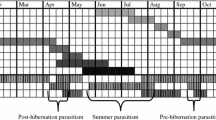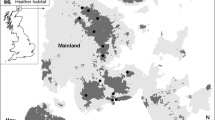Abstract
Theory predicts that habitat fragmentation, including reduced area and connectivity of suitable habitat, changes multitrophic interactions. Species at the bottom of trophic cascades (host plants) are expected to be less negatively affected than higher trophic levels, such as herbivores and their parasitoids or predators. Here we test this hypothesis regarding the effects of habitat area and connectivity in a trophic system with three levels: first with the population size of the larval food plant Hippocrepis comosa, next with the population density of the monophagous butterfly species Polyommatus coridon and finally with its larval parasitism rate. Our results show no evidence for negative effects of habitat fragmentation on the food plant or on parasitism rates, but population density of adult P. coridon was reduced with decreasing connectivity. We conclude that the highly specialized butterfly species is more affected by habitat fragmentation than its larval food plant because of its higher trophic position. However, the butterfly host species was also more affected than its parasitoids, presumably because of lower resource specialization of local parasitoids which also frequently occur in alternative hosts. Therefore, conservation efforts should focus first on the most specialized species of interaction networks and second on higher trophic levels.

Similar content being viewed by others
References
Anton C, Zeisset I, Musche M, Durka W, Boomsma JJ, Settele J (2007) Population structure of a large blue butterfly and its specialist parasitoid in a fragmented landscape. Mol Ecol 16:3828–3838
Asher J, Warren M, Fox R, Harding P, Jeffcoate G, Jeffcoate S, Greatorex-Davies N, Roberts E (2001) The millenium atlas of butterflies in Britain and Ireland. Oxford University Press, Oxford
Baguette M, Petit S, Quéva F (2000) Population spatial structure of three butterfly species within the same habitat network: consequences for conservation. J Appl Ecol 37:100–108
Balmer O, Erhardt A (2000) Consequences of succession on extensively grazed grasslands for central European butterfly communities: rethinking conservation practices. Conserv Biol 14:746–757
Baumgarten HT, Fiedler K (1998) Parasitoids of lycaenid butterfly caterpillars: different patterns in resource use and their impact on the hosts’ symbiosis with ants. Zoologischer Anzeiger 236:167–180
Belshaw R (1993) Tachinid flies: Diptera: Tachinidae. Royal Entomological Society, London
Böhmer HJ (1994) Die Halbtrockenrasen der Fränkischen Alb–Strukturen, Prozesse, Erhaltung. Mitteilungen der Fränkischen Geographischen Gesellschaft 41:323–343
Brereton TM, Warren MS, Roy DB, Stewart K (2008) The changing status of the Chalkhill Blue butterfly Polyommatus coridon in the UK: the impacts of conservation policies and environmental factors. J Insect Conserv 12:629–638
Brückmann SV, Krauss J, Steffan-Dewenter I (2010) Butterfly and plant specialists suffer from reduced connectivity in fragmented landscapes. J Appl Ecol 47:799–809
Cowley MJR, Thomas CD, Roy DB, Wilson RJ, León-Cortés JL, Gutiérrez D, Bulman CR, Quinn RM, Moss D, Gaston KJ (2001) Density-distribution relationships in British butterflies. I. The effect of mobility and spatial scale. J Anim Ecol 70:410–425
Cronin JT (2003) Patch structure, oviposition behaviour, and the distribution of parasitism risk. Ecol Monogr 73:283–300
Dauber J, Bengtsson J, Lenoir L (2006) Evaluating effects of habitat loss and land-use continuity on ant species Richness in seminatural grassland remnants. Conserv Biol 20:1150–1160
Debinski DM, Holt RD (2000) A survey and overview of habitat fragmentation experiments. Conserv Biol 14:342–355
Dennis RLH, Eales HT (1997) Probability of site occupancy in the large heath butterfly Coenonympha tullia determined from geographical and ecological data. Biol Conserv 87:295–301
Didham RK, Ghazoul J, Stork N, Davis AJ (1996) Insects in fragmented forests: a functional approach. Trends Ecol Evol 11:255–260
Doak P (2000) The effects of plant dispersion and prey density on parasitism rates in a naturally patchy habitat. Oecologia 122:556–567
Dobson A, Lodge D, Alder J, Cumming GS, Keymer J, McGlade J, Mooney H, Rusak JA, Sala O, Wolters V, Wall D, Winfree R, Xenopoulos M (2006) Habitat loss, trophic collapse, and the decline of ecosystem services. Ecology 87:1915–1924
Dupont YL, Nielsen BO (2006) Species composition, feeding specificity and larval trophic level of flower-visiting insects in fragmented versus continuous heathlands in Denmark. Biol Conserv 131:475–485
Ebert G, Rennwald E (1991) Die Schmetterlinge Baden-Württembergs. Band 2, Tagfalter II. Ulmer, Stuttgart
ESRI (1995) ArcView GIS for Windows, version 3.2. ESRI, Redlands
Ewers RM, Didham RK (2006) Confounding factors in the detection of species responses to habitat fragmentation. Biol Rev 81:117–142
Fahrig L (2003) Effects of habitat fragmentation on biodiversity. Annu Rev Ecol Evol Syst 34:487–515
Fiedler K, Seufert P, Pierce NE, Pearson JG, Baumgarten H-T (1992) Exploitation of lycaenid-ant mutualism by braconid parasitoids. J Res Lepidoptera 31:153–168
Golden DM, Christ TO (1999) Experimental effects of habitat fragmentation on old-field canopy insects: community, guild and species responses. Oecologia 118:371–380
Hance T, Baaren J, van Vernon P, Boivin G (2007) Impact of extreme temperatures on parasitoids in a climate change perspective. Annu Rev Entomol 52:107–126
Hanski I (1994) A practical model of metapopulation dynamics. J Anim Ecol 63:151–162
Hanski I, Moilanen A, Gyllenberg M (1996) Minimum viable metapopulation size. Am Nat 147:527–541
Hinz R, Horstmann K (2007) On the host relationships of European species of Ichneumon Linnaeus (Insecta, Hymenoptera, Ichneumonidae, Ichneumoninae). Spixiana 30:39–63
Holt RD (2002) Food webs in space: on the interplay of dynamic instability and spatial processes. Ecol Res 17:261–273
Horstmann K, Fiedler K, Baumgarten HT (1997) Zur Taxonomie und Bionomie einiger Ichneumonidae (Hymenoptera) als Parasitoide westpaläarktischer Lycaenidae (Lepidoptera). Nachrichtenblatt der Bayerischen Entomologen 46(1/2):2–7
Hunter MD (2001) Multiple approaches to estimating the relative importance of top-down and bottom-up forces on insect populations: experiments, life tables, and time-series analysis. Basic Appl Ecol 2:295–309
Komonen A, Penttilä R, Lindgren M, Hanski I (2000) Forest fragmentation truncates a food chain based on an old-growth forest bracket fungus. Oikos 90:119–126
Krauss J, Steffan-Dewenter I, Tscharntke T (2003) How does landscape context contribute to effects of habitat fragmentation on diversity and population density of butterflies? J Biogeor 30:889–900
Krauss J, Schmitt T, Seitz A, Steffan-Dewenter I, Tscharntke T (2004) Effects of habitat fragmentation on the genetic structure of the monophagous butterfly Polyommatus coridon along its northern range margin. Mol Ecol 13:311–320
Krauss J, Steffan-Dewenter I, Müller CB, Tscharntke T (2005) Relative importance of resource quantity, isolation and habitat quality for landscape distribution of a monophagous butterfly. Ecography 28:465–474
Krauss J, Bommarco R, Guardiola M, Heikkinen RK, Helm A, Kuussaari M, Lindborg R, Öckinger E, Pärtel M, Pino J, Pöyry J, Raatikainen KM, Sang A, Stefanescu C, Teder T, Zobel M, Steffan-Dewenter I (2010) Habitat fragmentation causes immediate and time-delayed biodiversity loss at different trophic levels. Ecol Lett 13:597–605
Kruess A, Tscharntke T (1994) Habitat fragmentation, species loss, and biological control. Science 264:1581–1584
Kudrna O (2002) The distribution atlas of European butterflies. Oedippus 20:1–342
Kuussaari M, Heliölä J, Luoto M, Pöyry J (2007) Determinants of local species richness of diurnal Lepidoptera in boreal agricultural landscapes. Agric Ecosyst Environ 122:366–376
Menéndez R, González-Megías A, Lewis OT, Shaw MR, Thomas CD (2008) Escape from natural enemies during climate-driven range expansion: a case study. Ecol Entomol 33:413–421
Moilanen A, Nieminen M (2002) Simple connectivity measures in spatial ecology. Ecology 83:1131–1145
Nouhuys van S (2005) Effects of habitat fragmentation at different trophic levels in insect communities. Ann Zool Fenn 42:433–447
Pärtel M, Mändla R, Zobel M (1999) Landscape history of a calcareous (alvar) grassland in Hanila, western Estonia, during the last three hundred years. Landsc Ecol 14:187–196
Pierce NE, Kitching RL, Buckley RC, Taylor MFJ, Benbow KF (1987) The costs and benefits of cooperation between the Australian lycaenid butterfly, Jalmenus evagoras, and its attendant ants. Behav Ecol Sociobiol 21:237–248
Poschlod P, WallisDeVries MF (2002) The historical and socioeconomic perspective of calcareous grasslands—lessons from the distant and recent past. Biol Conserv 104:361–376
R Development Core Team (2009) R: a language and environment for statistical computing. Foundation for statistical computing Vienna. URL: http://www.r-project.org
Roland J, Taylor PD (1997) Insect parasitoid species respond to forest structure at different spatial scales. Nature 386:710–713
Saccheri I, Kuussaari M, Kankare M, Vikman P, Fortelius W, Hanski I (1998) Inbreeding and extinction in a butterfly metapopulation. Nature 392:491–494
Saunders DA, Hobbs RJ, Margules CR (1991) Biological consequences of ecosystem fragmentation: a review. Conserv Biol 5:18–32
Schmitt T, Habel JC, Besold J, Becker T, Johnen L, Knolle M, Rzepecki A, Schultze J, Zapp A (2006) The Chalk-hill Blue Polyommatus coridon (Lycaenidae, Lepidoptera) in a highly fragmented landscape: how sedentary is a sedentary butterfly? J Insect Conserv 10:311–316
Settele J, Feldmann R, Reinhardt R (2000) Die Tagfalter Deutschlands. Ulmer, Stuttgart
Shaw MR, Stefanescu C, van Nouhuys S (2009) Parasitoids of European butterflies. In: Settele J, Shreeve T, Konvicka M, Van Dyck H (eds) The ecology of butterflies in Europe. Cambridge University Press, New York, pp 130–156
Steffan-Dewenter I (2003) Importance of habitat area and landscape context for species richness of bees and wasps in fragmented orchard meadows. Conserv Biol 17:1036–1044
Steffan-Dewenter I, Tscharntke T (1999) Effects of habitat isolation on pollinator communities and seed set. Oecologia 121:432–440
Tscharntke T, Kruess A (1999) Habitat fragmentation and biological control. In: Hawkins BA, Cornell HV (eds) Theoretical approaches to biological control. Cambridge University Press, Cambridge, pp 190–205
Tscharntke T, Steffan-Dewenter I, Kruess A, Thies C (2002a) Characteristics of insect populations on habitat fragments: a mini review. Ecol Res 17:229–239
Tscharntke T, Steffan-Dewenter I, Kruess A, Thies C (2002b) Contribution of small habitat fragments to conservation of insect communities of grassland-cropland landscapes. Ecol Appl 12:354–363
Tylianakis JM, Tscharntke T, Lewis OT (2007) Habitat modification alters the structure of tropical host–parasitoid food webs. Nature 445:202–205
Valladares G, Salvo A, Cagnolo L (2006) Habitat fragmentation effects on trophic processes of insect-plant food webs. Conserv Biol 20:212–217
Van Swaay CAM (2002) The importance of calcareous grasslands for butterflies in Europe. Biol Conserv 104:315–318
Vanbergen AJ, Hails RS, Watt AD, Jones TH (2006) Consequences for host-parasitoid interactions of grazing-dependent habitat heterogeneity. J Anim Ecol 75:789–801
Weidemann HJ (1995) Tagfalter beobachten, bestimmen. Naturbuch, Augsburg
Zabel J, Tscharntke T (1998) Does fragmentation of Urtica habitats affect phytophagous and predatory insects differentially? Oecologia 116:419–425
Acknowledgments
We thank Kathrin Wagner and two anonymous reviewers for helpful comments on the manuscript, Emily Martin for improvement of English, Hans-Peter Tschorsnig for determination of the tachinid flies, and Linda Seifert and Christoph Brütting for their work assistance in the season 2008. This project was supported by the EU 6FP project COCONUT (Understanding effects of land use changes on ecosystems to halt loss of biodiversity due to habitat destruction, fragmentation and degradation; Contract Number 2006-044346 to ISD and JK; www.coconut-project.net) and in part by the EU FP7 SCALES project (“Securing the conservation of biodiversity across administrative levels and spatial, temporal and ecological scales”; project #226852).
Author information
Authors and Affiliations
Corresponding author
Rights and permissions
About this article
Cite this article
Brückmann, S.V., Krauss, J., van Achterberg, C. et al. The impact of habitat fragmentation on trophic interactions of the monophagous butterfly Polyommatus coridon . J Insect Conserv 15, 707–714 (2011). https://doi.org/10.1007/s10841-010-9370-7
Received:
Accepted:
Published:
Issue Date:
DOI: https://doi.org/10.1007/s10841-010-9370-7




